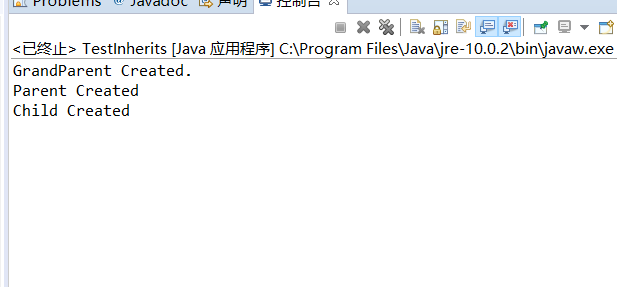一:继承条件下的构造方法调用
程序代码:
class Grandparent { public Grandparent() { System.out.println("GrandParent Created."); } public Grandparent(String string) { System.out.println("GrandParent Created.String:" + string); } } class Parent extends Grandparent { public Parent() { //super("Hello.Grandparent."); System.out.println("Parent Created"); // super("Hello.Grandparent."); } } class Child extends Parent { public Child() { System.out.println("Child Created"); } } public class TestInherits { public static void main(String args[]) { Child c = new Child(); } }
程序截图:

结论:(1)通过 super 调用基类构造方法,必须是子类构造方法中的第一个语句。
(2)当我们去运行代码的时候,父类的构造函数会先于子类的构造函数。然后,在当我们把子类中的父类的构造方法取消注释,我们会发现同样的结果,然后当我们把父类的构造方法放入子类的构造方法之后,我们会发现,代码无法编译通过,由此得到结论。
二:怎样判断对象是否可以转换?
可以使用instanceof运算符判断一个对象是否可以转换为指定的类型:
Object obj="Hello";
if(obj instanceof String)
System.out.println("obj对象可以被转换为字符串");
程序代码:
public class TestInstanceof { public static void main(String[] args) { //声明hello时使用Object类,则hello的编译类型是Object,Object是所有类的父类 //但hello变量的实际类型是String Object hello = "Hello"; //String是Object类的子类,所以返回true。 System.out.println("字符串是否是Object类的实例:" + (hello instanceof Object)); //返回true。 System.out.println("字符串是否是String类的实例:" + (hello instanceof String)); //返回false。 System.out.println("字符串是否是Math类的实例:" + (hello instanceof Math)); //String实现了Comparable接口,所以返回true。 System.out.println("字符串是否是Comparable接口的实例:" + (hello instanceof Comparable)); String a = "Hello"; //String类既不是Math类,也不是Math类的父类,所以下面代码编译无法通过 //System.out.println("字符串是否是Math类的实例:" + (a instanceof Math)); } }
程序截图:

三:“类型转换”
程序代码:
package test; class Mammal{} class Dog extends Mammal {} class Cat extends Mammal{} public class TestCast { public static void main(String args[]) { Mammal m; Dog d=new Dog(); Cat c=new Cat(); m=d; //d=m; d=(Dog)m; //d=c; //c=(Cat)m; } }
结论:
子类对象可以直接赋给基类变量。
基类对象要赋给子类对象变量,必须执行类型转换,
其语法是: 子类对象变量=(子类名)基类对象名;
四:子类父类拥有同名的方法时
当子类与父类拥有一样的方法,并且让一个父类变量引用一个子类对象时,到底调用哪个方法,由对象自己的“真实”类型所决定,这就是说:对象是子类型的,它就调用子类型的方法,是父类型的,它就调用父类型的方法。 这个特性实际上就是面向对象“多态”特性的具体表现。
程序代码:
public class ParentChildTest { public static void main(String[] args) { Parent parent=new Parent(); parent.printValue(); Child child=new Child(); child.printValue(); parent=child; parent.printValue(); parent.myValue++; parent.printValue(); ((Child)parent).myValue++; parent.printValue(); } } class Parent{ public int myValue=100; public void printValue() { System.out.println("Parent.printValue(),myValue="+myValue); } } class Child extends Parent{ public int myValue=200; public void printValue() { System.out.println("Child.printValue(),myValue="+myValue); } }
程序截图:

结论1:当子类与父类拥有一样的方法,并且让一个父类变量引用一个子类对象时,到底调用哪个方法,由对象自己的“真实”类型所决定,这就是说:对象是子类型的,它就调用子类型的方法,是父类型的,它就调用父类型的方法。
结论2:如果子类与父类有相同的字段,则子类中的字段会代替或隐藏父类的字段,子类方法中访问的是子类中的字段(而不是父类中的字段)。如果子类方法确实想访问父类中被隐藏的同名字段,可以用super关键字来访问它。